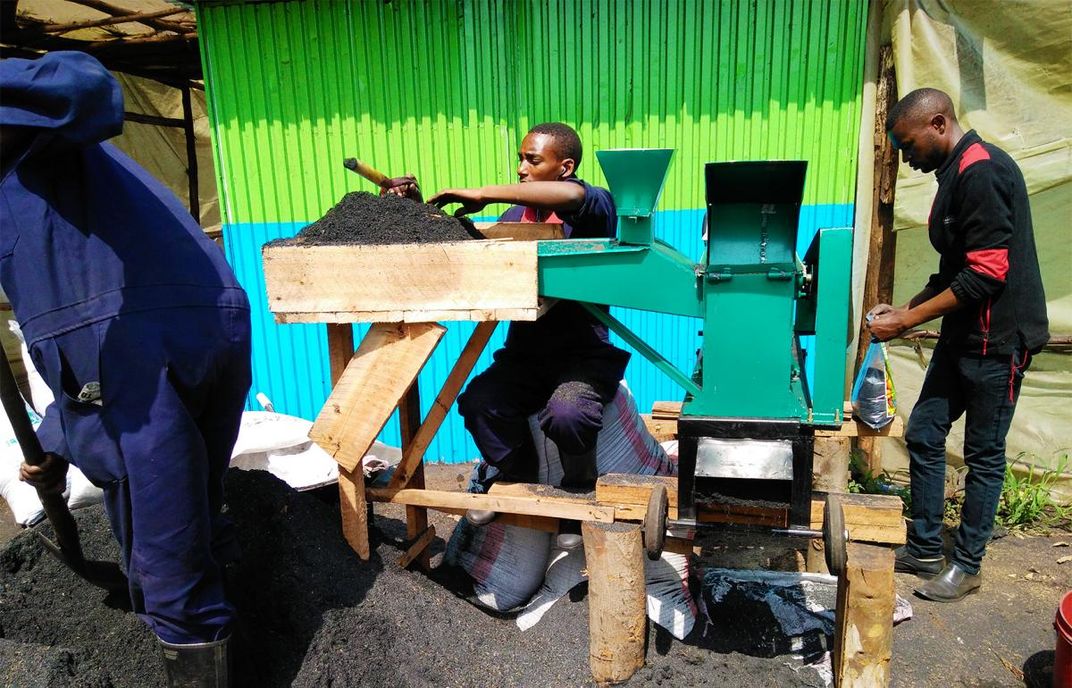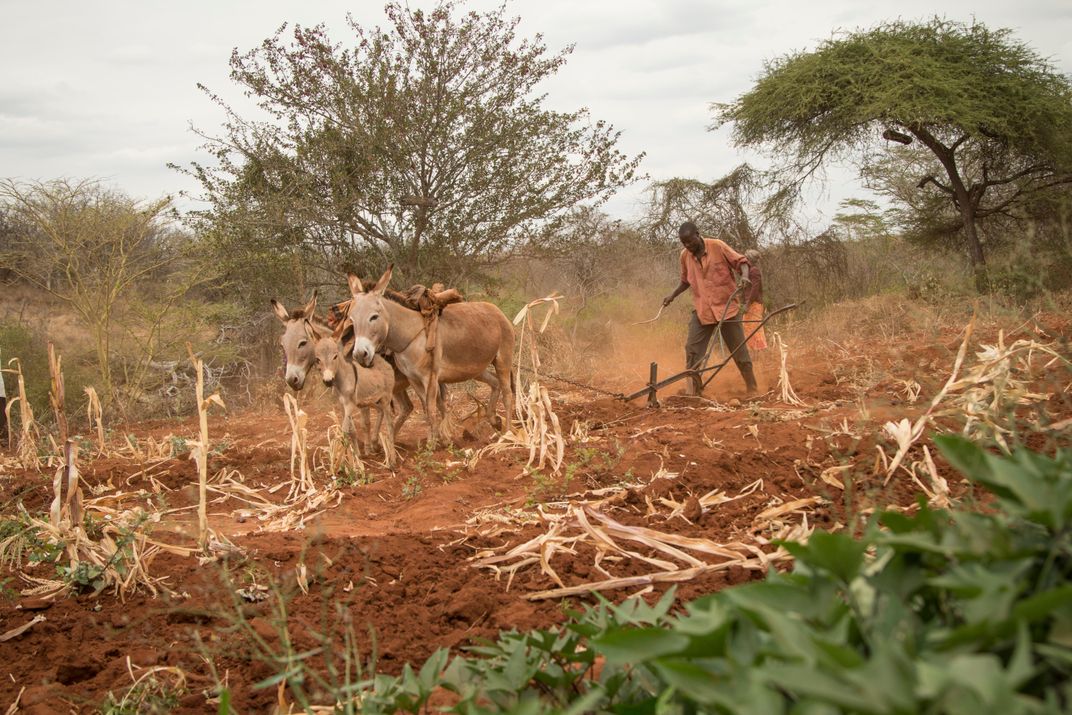How Climate Change is Fueling Innovation in Kenya
A new generation of start ups are working to help farmers in a region that faces myriad challenges
/https://tf-cmsv2-smithsonianmag-media.s3.amazonaws.com/filer/00/c6/00c60ebe-b70a-4328-bd87-ecedda22d109/using-our-product.jpg)
In the spring of 1997, El Niño struck Kenya. Although he was only eight years old at the time, Samuel Rigu vividly recalls that time—the 10 months of heavy rainfall, the nationwide devastation. “The food in the farm was completely destroyed by the floods,” he says now. “But worst of all was the famine that followed.”
Rigu grew up the son of peasants in a maize farm north of Nairobi. Like other small-scale farmers in Kenya, his family relied on a small parcel of land for making a living. Although agriculture is the backbone of the country’s economy, accounting for approximately a fourth of annual GDP, Africa south of the Sahara isn’t famous for being particularly suited for farming.
The quality of the soil is notoriously poor across the region, and the average crop yield is the lowest in the world. High import and transportation costs make seeds and fertilizer more expensive than anywhere else on the planet, while cyclic droughts pose a serious threat to crops production in a region where 98 percent is rain-fed. Phenomena like El Niño, which occurred most recently in 2015, are just one more challenge that threatens subsistence farmers.
And now there’s climate change, which in recent years has made for higher temperatures and increasingly erratic weather patterns. Small-scale farmers, who are extremely dependent on any slight weather changes as the seasons tightly govern their produce, are arguably the most affected category. “These are all effects I experienced first-hand,” says Rigu, who started operating his own corn farm soon after college.
One day in 2014, on a shopping trip to the rice-trading hub of Mwea, Rigu had an insight. In front of each rice processor’s storefront there were heaps of chaff, the almost weightless husk that is separated from the grains during the harvest. Many of the heaps had been set on fire—a process that releases toxic pollutants—just to dispose of the stuff. But where most people saw waste, Rigu saw an opportunity.
“I thought that what I was seeing many farmers doing was not right,” he says, “so I researched on how best the waste could be recycled to make it into something both economically and environmentally viable.”

Today Rigu has quit his maize farm and runs a flourishing business, Safi Organics, which turns chaff into an organic conditioner called Safi Sarvi. Rigu buys rice husks, maize combs and other agricultural waste from a local network of rice processors for almost nothing, around $30 per metric ton. Then he slow burns it and adds a mixture of minced limestone and other vegetal ingredients to create a sort of charcoal, which can be used as fertilizer. He sells the fertilizer back to local farmers for $15 per 50-kg (110-pound) bag, netting Rigu up to $200 for each processed ton.
Farmers who use it have seen their farm yields increase up to 30 percent, and their income by up to 50 percent. “The fertilizer has a higher retention of water and nutrients over time versus traditional fertilizers, and also is slightly alkaline, preventing soil acidification,” says Rigu. “Most important, for every acre of land that uses our product, 1.7 tons of CO2 equivalent are sequestered from the atmosphere."
In 2016, Rigu won the the Total Startupper of the Year award across 34 African countries, and placed second in the MIT Food and Agribusiness Innovation Prize. Rigu’s spirit of enterprise typifies a larger trend unfolding across the country, where a market to provide small-scale farmers with the tools they desperately need to handle global warming is gradually emerging.
“Smallholder farmers are already paying the price for climate change,” says Kiette Tucker, country director of One Acre Found, a Kakamega-based nonprofit founded in 2006 that supplies smallholder farmers with tools and financing instruments. “To cope with it, they need better access to water, inexpensive new irrigation products, more insurance providers and more financial inclusion. That will allow them to produce much more than before, and become more resilient to shocks.”
One Acre Fund grants small loans in the form of seeds and fertilizers delivered directly to the farmers. Once they receive the loans, they have a year to pay back. Each loan is about $100, and has an embedded insurance policy so farmers aren’t at risk in the case of crop loss. In a decade, it grew from the initial 37 clients to more than 200,000 Kenyan farmers, as well as several others in a number of countries across East Africa.
“We're encouraging (Kenyan farmers) to diversify their income and offering climate-friendly products like solar lights and energy-efficient cook stoves,” she continues. “But there’s a major hurdle to overcome: We need more funders who are willing to invest in our research and development work as we seek new ideas to better support climate change mitigation and adaptation.”

Access to financing has always been a challenge. Local banks are reluctant to help small-scale farmers, as they typically have little or nothing to offer in return. In addition, good ideas aimed at improving their situation struggle to find money to start, since there are still few financial institutions willing to gamble on unproven ventures.
But thanks to companies like One Acre Fund, farmers’ access to financial resources—from loans to weather-based insurance programs—seems to be improving across the country. For instance, Africa’s largest weather-based insurance program—known as ACRE—added more than 1,000,000 farmers between 2009 and 2017. Last year, the government launched a program to address the challenges that agricultural producers face when there are large production shocks, such as droughts and floods. The government basically acts as a middleman between traditional insurers and farmers, purchasing insurance from private companies on their behalf.
Kenya Climate Innovation Center is an example. A startup incubator based at Strathmore University in Nairobi, it takes funds from the World Bank and the Danish and British governments, and then distributes small grants ranging from a few hundred to a few thousand U.S. dollars to accelerate the development of climate-related, locally relevant startups. Since it opened in 2012, it's subsidized hundreds of projects.
“That suggests Kenyans are developing an increased awareness of the issue,” says Izael Pereira Da Silva, the chairman of KCIC. “And that’s good to know, as temperatures are undeniably rising, and agriculture is the most vulnerable of the sectors.”
Among the many projects that took advantage of this opportunity was Kenya Biologics, a company that sells an all-natural pesticide targeted at crop-destroying caterpillars, which allows farmers to reduce chemical residues on crops and improve pest control. Originally focused on large-scale commercial farmers, it’s increasingly attentive to small-scale farmers’ needs.
“Small-scale farming is increasingly becoming more sophisticated in Kenya,” says Chris Kolenberg, CEO of the firm. “It’s no surprise: as most Sub-Saharan African countries are mainly agricultural nations, that this has and always will be an open ground for innovations based on improving farming methods.”
Of course, there’s lot of work yet to be done. Small-scale farmers tend to be conservative in their approach, and Kolenberg finds difficult to convince them to use natural products on the argument that it is better for the environment. “Our products are climate smart, but many are using them merely based on the argument that it is cheaper,” he says. The problem is if that changes: “If they could use another product which is cheaper but strains the environment, they will use that.”
But initiatives like those outlined above are trying to turn the tide by creating a positive feedback loop. “With the majority of smallholder farmers in Kenya falling below or within the poverty index, it might be difficult to get them to adopt more technologic and environmentally-friendly options which are usually costlier,” maintains Da Silva. “But if we manage to make Kenyan small-scale farmers able to buy technology, the country’s climate innovation sector develops, making technology cheaper and easier to come by. The end result is an enhanced national economy, with the weakest parts made more resilient and less vulnerable to the menace of climate change.”